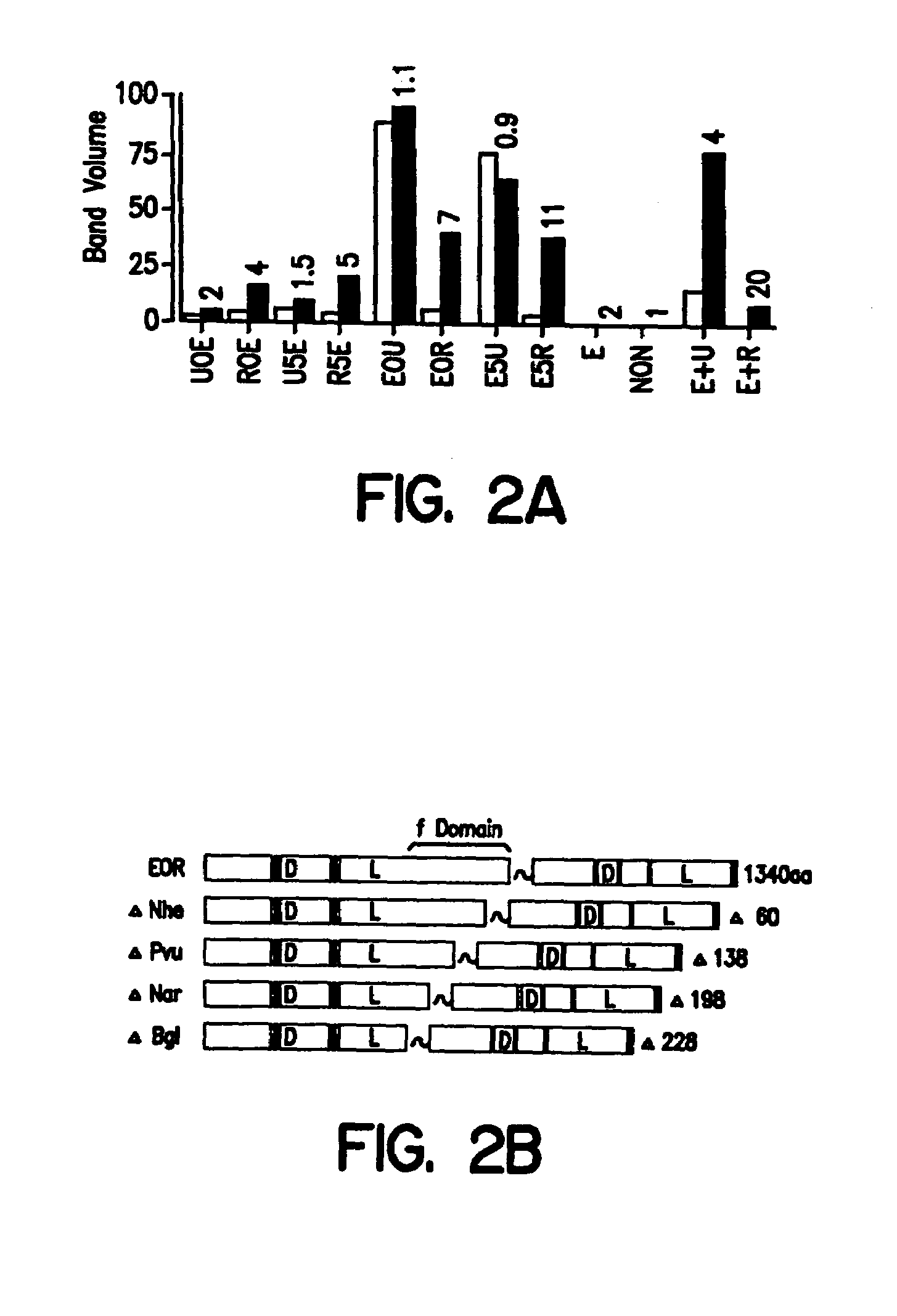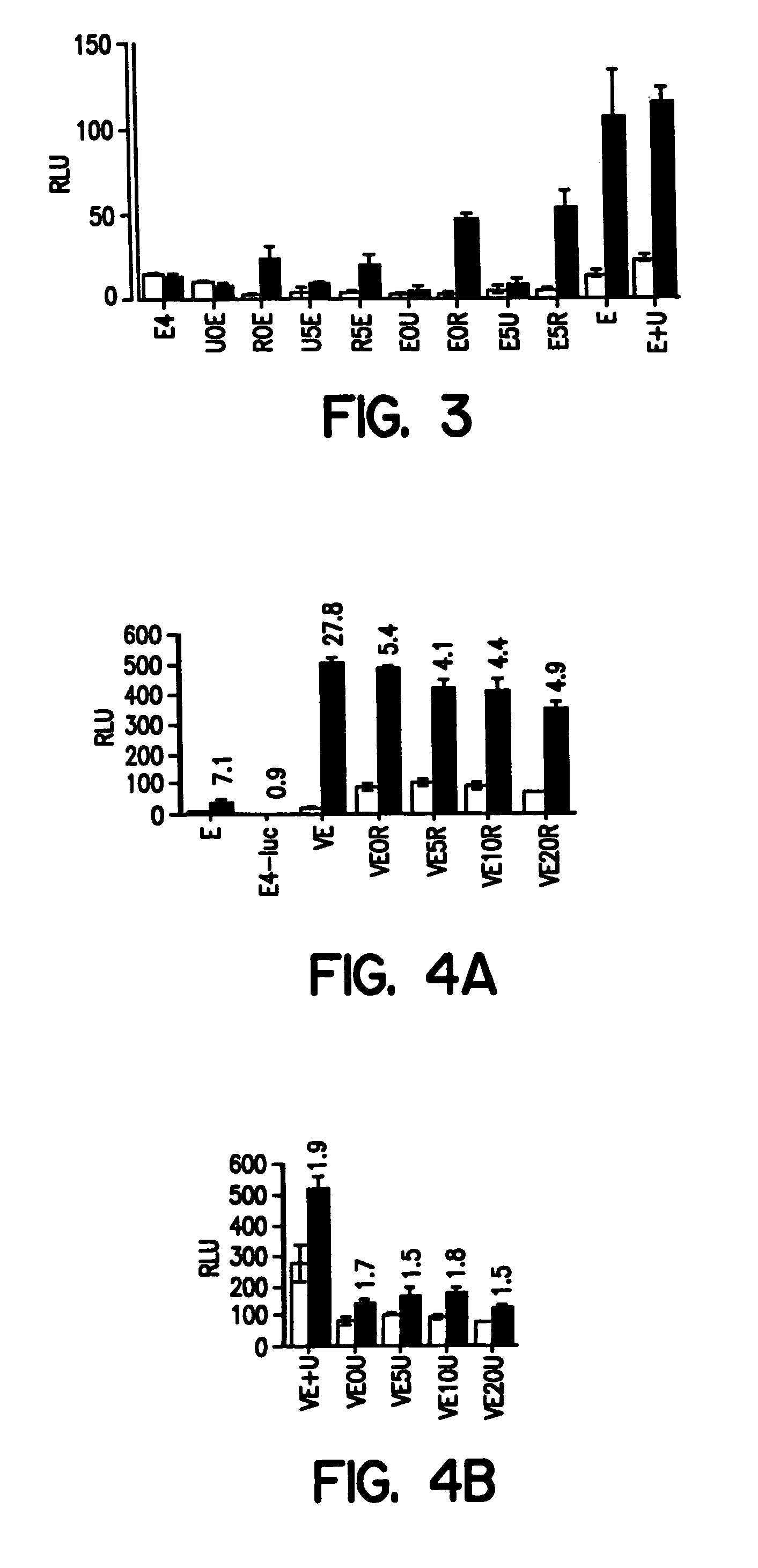Hormone receptor functional dimers and methods of their use
a hormone receptor and functional dimer technology, applied in the field of recombinant dna technology, can solve the problems of slow clearance of antibiotics from bone, interference with gene expression regulation, and difficulty in producing fusion proteins with multiple functions, so as to enhance the possibility of producing a functional entity and enhance the flexibility for proper folding
- Summary
- Abstract
- Description
- Claims
- Application Information
AI Technical Summary
Benefits of technology
Problems solved by technology
Method used
Image
Examples
example 1
Design of Ecdysone Receptor-Usp / RXR Functional Dimers
[0217]Two classes of chimeric proteins were constructed as fusion proteins to study the activity of EcR-Usp / RXR functional dimers. In one class, EcR is at the N-terminus of a fusion protein, and in the other class the binding partner (either Usp or RXR) is at the N-terminus (FIG. 1). To facilitate formation of the functional dimers and allow for insertion of polypeptide linkers between the receptor and its binding partner in the fusion protein, a 5 amino acid bridge that also encodes the restriction endonuclease site for SfiI was inserted between the two open reading frames (ORFs).
[0218]A double stranded SfiI compatible oligonucleotide encoding the amino acid sequence GPGGGSGGGSGT (SEQ ID NO:17) was designed to provide a high degree of predicted flexibility while attempting to minimize repetitive sequence within the oligonucleotide. This nucleotide sequence incorporated the SfiI site at the 5′ end of the insert to allow for ease i...
example 2
Transfection of FD Constructs
[0231]For quantitative transactivation analysis, transfections were performed in triplicate in 24-well plates by calcium-phosphate co-precipitation with 100 ng of an individual receptor, the reporter plasmid E4-luc, and pCH110 (SV40-β-galactosidase) as an internal control. Briefly, the reporter plasmid, E4-luc, was constructed of 4-tandem EcREs inserted upstream of a thymidine kinase gene minimal promoter directing luciferase expression. EcRE oligonucleotides were as described by Thomas et al., supra (1993) with BamHI / BglII compatible ends. 1 μM ligand was added at the time of transfection, and the cells were harvested for luciferase assay 40 hours later. Harvested cell extracts were split, and one part was analyzed in a luminometer for luciferase activity and the other part was analyzed for β-galactosidase activity using an orthonitrophenyl galactoside assay by standard methods. Luciferase levels were normalized to β-galactosidase values to correct for ...
example 3
Gel Mobility Shift Analysis
[0233]Comparative gel mobility shift analyses of FDs with control in vitro translated receptor complexes were performed using double stranded EcRE probes and labeled by Klenow fill using 32P-dCTP and cold dGAT by standard methods. In vitro translated proteins used as controls were produced using the T3 / T7 TNT (Promega) transcription / translation system following the manufacturer's protocol. In vitro translated proteins were qualitatively examined by 5% SDS-PAGE using protocols as described (J. Sambrook et al. Molecular Cloning: A Laboratory Manual, Cold Spring Harbor Press, Cold Spring Harbor, N.Y., 1989) to ensure the presence of full-length products of the proper molecular weight. Reaction conditions for protein-probe interaction and gel electrophoresis were essentially identical to those disclosed in Yao et al., supra 1992. However, to improve comparison between samples, reaction mixtures (including dimer partners and probe) were prepared as a cocktail a...
PUM
| Property | Measurement | Unit |
|---|---|---|
| lengths | aaaaa | aaaaa |
| lengths | aaaaa | aaaaa |
| body weight | aaaaa | aaaaa |
Abstract
Description
Claims
Application Information
 Login to View More
Login to View More - R&D
- Intellectual Property
- Life Sciences
- Materials
- Tech Scout
- Unparalleled Data Quality
- Higher Quality Content
- 60% Fewer Hallucinations
Browse by: Latest US Patents, China's latest patents, Technical Efficacy Thesaurus, Application Domain, Technology Topic, Popular Technical Reports.
© 2025 PatSnap. All rights reserved.Legal|Privacy policy|Modern Slavery Act Transparency Statement|Sitemap|About US| Contact US: help@patsnap.com



